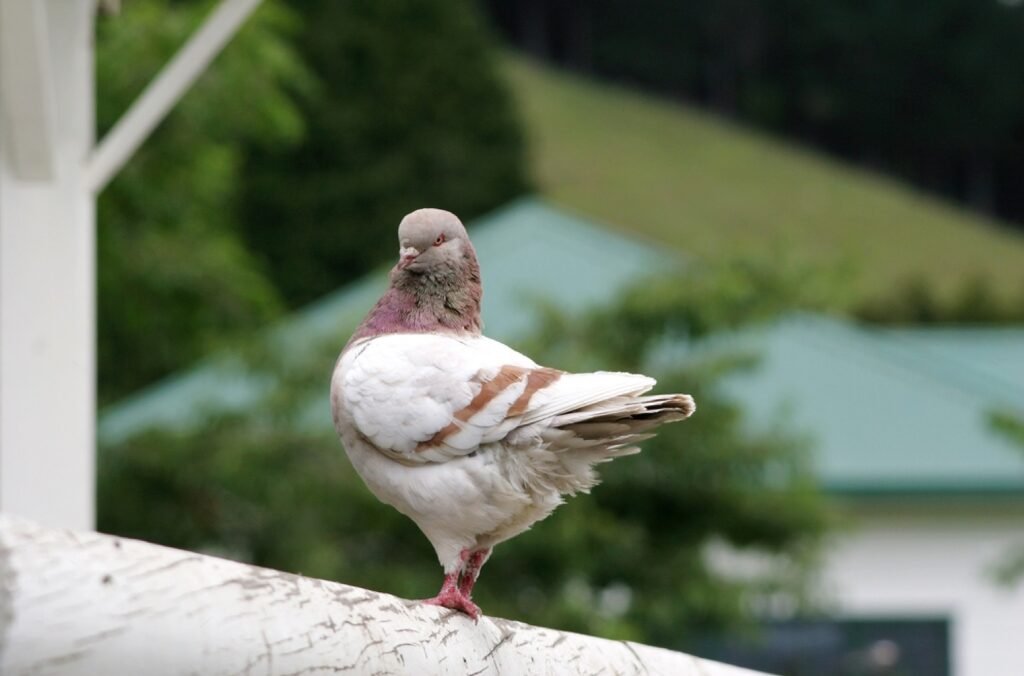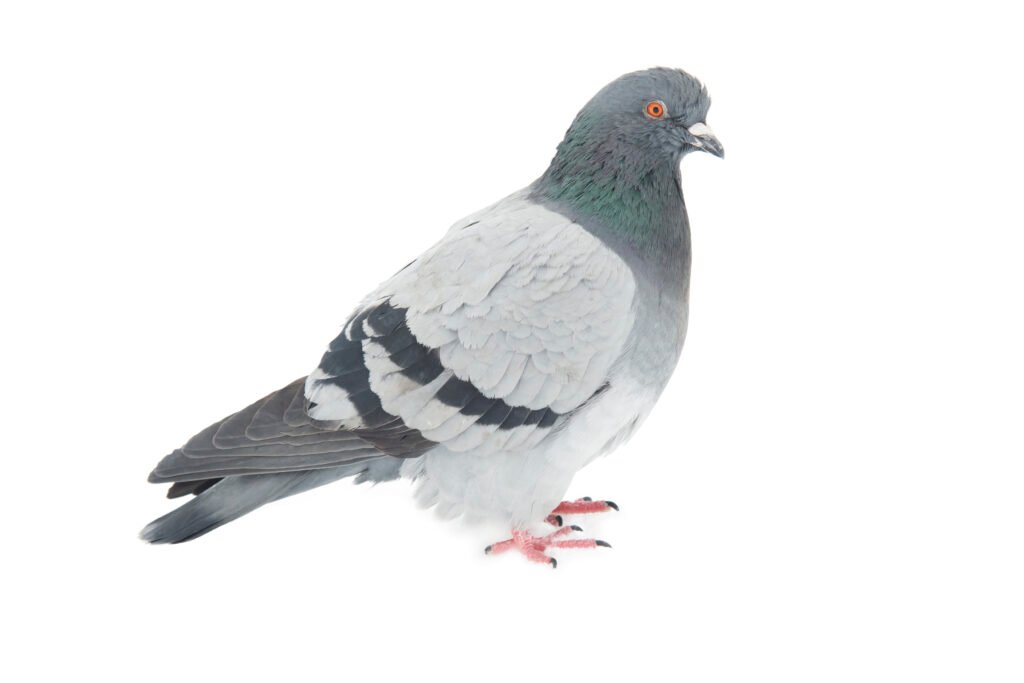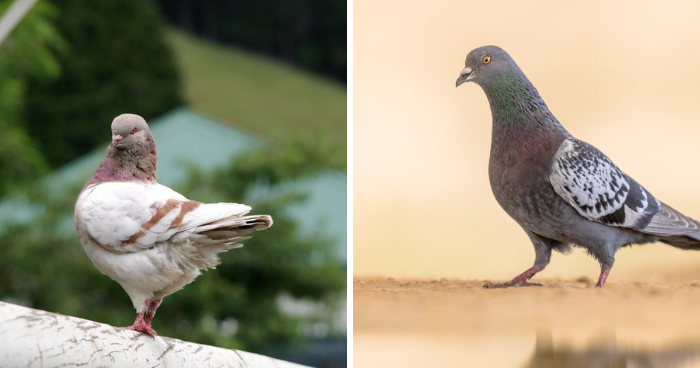Pigeons have been a part of human culture for thousands of years, functioning as messengers, racecar drivers, and beloved pets. With hundreds of breeds worldwide, domestic pigeons come in a variety of colors, sizes, and talents. Some kinds are prized for their beauty, while others are raised for speed or meat output.
In this article, we will look at the interesting world of domestic pigeon breeds, their characteristics, and how to care for these amazing birds.
A Brief History of Domestic Pigeons
Rock doves, which lived on cliffs and beaches, gave rise to domestic pigeon breeds. Domestication followed thousands of years of human recognition of their intelligence, homing ability, and adaptability.
Pigeons carried vital information from ancient Mesopotamia to medieval Europe. They symbolized love and peace in art and religion and were beloved by royalty and commoners. We still love domestic pigeons, with breeds for sport, display, and friendship.
The Anatomy of a Pigeon: Key Features Across Breeds
Pigeons’ amazing anatomy aids flying, survival, and flexibility. Their small bodies, powerful wings, and light skeletons make them fast fliers. Survival requires complex breathing systems, a streamlined beak for food, and sharp vision for navigation.
All pigeons are similar, but each breed is unique. Utility breeds favor power and bulk, whereas fancy varieties may have elaborate crests or fan-shaped tails. These distinctions help identify breeds and appreciate their distinctive traits.
Related Read: A Detailed Guide to Top Rabbit Breeds
Classification of Domestic Pigeon Breeds
There are three main types of domestic pigeons based on their use: fancy, flying/sporting, and utility. Each group has unique traits that help them do their jobs, whether for looks, performance, or usefulness.
Fancy Breeds
These pigeons are primarily grown for their beautiful looks and as decorations. Fancy breeds are often shown at shows and are valued for their beautiful feathers, unique feather patterns, and unique shapes. The Jacobin, with its royal feathered hood, and the Fantail, with its beautiful fan-shaped tail, are two examples.
Sporting and flying breeds
Pigeons that are bred to fly well are called flying and sports pigeons. People often race these types and use them for their acrobatic skills. Some of them are homing pigeons, known for being great at finding their way, and rollers, which do tricks in the air like backward somersaults.
Utility Breeds
Utility breeds are bred to do valuable things, like produce meat or be used as working birds. These pigeons are usually bigger and stronger because they were chosen for their ability to have good babies or do specific jobs. The King pigeon is a popular example because it is big and juicy, and the Carneau is a popular example because it is challenging and has a lot of meat.
Each group has its purpose, but they all add to the beauty and variety of the world of tame pigeons.
Fancy Breeds: Beauty in Diversity
Fancy pigeon breeds are known for their beautiful traits and individual appearances, each of which exudes charm. These birds are bred for their beauty, making them famous in shows and valued companions. Here are some of the most appealing fancy breeds:
Jacobin, The Feathered Monarch

Credit: Envato
The Jacobin distinguishes itself with its beautiful feathered hood, which frames its head like a crown. This exquisite breed is typically seen as a symbol of luxury and is popular in pigeon shows.
Fantail, The Graceful Performer

Credit: Envato
The Fantail captivates with its unique fan-shaped tail, which spreads like a delicate dancer. This breed is renowned for its grace and beauty, making it an ideal addition to any pigeon collection.
Modena: Compact and Vibrant

The Modena is distinguished by its sturdy, compact body and bright plumage. Its tranquil attitude and visual attractiveness make it popular among fans looking for beauty and charm.
Fancy breeds demonstrate the richness and originality of the pigeon world, providing insight into how nature and human skill combine to create stunning avian art.
Flying and Sporting Breeds: Champions of the Skies
Flying and sporting pigeon breeds are recognized for their agility, stamina, and amazing aerial talents. These breeds are selectively selected for their capacity to thrive in flight-related activities, making them favourites among racing and performance fans. Below are some of the most exceptional flying and sporting breeds:
Homing Pigeon: The Master Navigator

Credit: Envato
The Homing Pigeon is known for its exceptional navigation ability, often crossing great distances to return home with astonishing accuracy. Its speed and reliability have made it a cornerstone of pigeon racing and history.
Tippler: The Endurance Flyer

Credit: Envato
Tipplers are noted for their remarkable stamina, which allows them to soar for hours without rest. This species is highly appreciated in endurance sports, as it exhibits physical resilience and mental focus.
Roller: The Aerial Acrobat

Credit: Envato
Rollers enchant onlookers with their unusual ability to complete backward somersaults mid-flight. These acrobatic moves make them an interesting choice for individuals who enjoy dynamic and entertaining flight displays.
Flying and sports breeds exemplify pigeons’ athletic capabilities, delivering exhilarating performances and a profound connection to their innate flying instincts.
Utility Breeds: Practical and Productive
Utility pigeon breeds are primarily raised for usefulness, like producing meat or other valuable things. People breed these birds to be big, strong, and good at what they do, which makes them useful on farms and in businesses. Here are a few of the most well-known utility breeds:
King Pigeon: The Gentle Giant

The King Pigeon is a strong breed known for being calm and impressively big. It is a safe source of high-quality chicken whose tender meat comes from being bred to produce meat.
Carneau: The Robust Worker

The Carneau is another proper breed that is liked for its size and toughness. Because it is big and strong, it is often raised for its meat and as a reliable breeder, making it an essential part of utility pigeon projects.
Several useful kinds of pigeons show how useful and adaptable the species is. They make a big difference in farming and other useful fields while still being tough and resilient.
Identifying Pigeon Traits by Breed
Each breed of pigeon has distinct physical qualities, making breed identification enjoyable. Each breed of pigeon has distinguishing traits, even though they all have a physique adapted for flight. Here are some key signs to identify a pigeon:
Style and Color of Plumage
Pigeons come in many colors, from shimmering to pure white and bright patterns. Fancy breeds like the Jacobin have feathers with many small details. Utility breeds, like the King pigeon, have feathers that are all the same color and are more prominent.
Size and shape of the body
The size and shape of a pigeon are good ways to tell what breed it is. Utility breeds, like the King pigeon and the Carneau, tend to be bigger, with wider bodies and more muscle. However, flying breeds like the Homing pigeon are more compact and lighter because they are meant to be fast and last long.
Shape of the Head and Beak
Each breed of pigeon has a different head and beak shape. Some breeds, like the Modena, have smaller, more compact heads with clear beaks, while the Jacobin has a unique feathery hood around its head.
Patterns of Flight
Some breeds have unique flight patterns that can help you tell them apart. Rollers are known for their amazing somersaults, while Tipplers are known for their long, steady rides.
By paying close attention to these traits, pigeon lovers can quickly tell the difference between breeds, which makes having pigeons even more enjoyable and appreciated.
How to Pick the Best Breed for You
Picking the right pigeon breed relies on several things, such as your experience level, the reason you want to keep pigeons, and the space you have for housing them. These steps will help you find the right breed for your needs:
Consider Your Purpose
Plan out what you want to do with your pigeons. If you use a bird to decorate, a fancy breed like the Jacobin or Fantail might be perfect because of their appearance. Some kinds, like the Homing pigeon or the Roller, might be better if you want to race or see how well they fly. If you want a dog for valuable reasons, breeds like the King and the Carneau can help you with things like raising meat.
Assess Your Experience Level
To take care of some pigeons is better than others. Starters are often told to get types like the Homing pigeon, which are hardy, friendly, and easy to train. Fancy and sporting breeds may need more care, attention, and understanding about what they need.
Evaluate Space and Housing Needs
Pets of different breeds need different amounts of room. Larger breeds, like the King pigeon, need more space to move around, but smaller breeds, like the Modena, can do well in smaller areas. Consider how much room you have for housing and whether you can give the breed you choose a safe and comfortable place to live.
How to Maintain and Adjust
Various pigeon breeds have diverse characteristics. The King pigeon is peaceful and gentle, whereas the restless Roller needs more attention. You should also consider upkeep. Some breeds require special food or hair care.
Consider these factors to choose a breed that fits your lifestyle, ambitions, and commitment. Pigeon keeping will be enjoyable and rewarding.
Caring for Domestic Pigeons
Domestic pigeons require attention to detail, routine, and love. Whether you keep them as pets, for breeding, or racing, providing a suitable habitat and care is critical to their health and happiness. Here’s how to help your pigeons thrive:
Providing a Safe and Comfortable Home
Pigeons require a clean, dry, and safe environment to live in. They require a large loft or pigeon coop with appropriate ventilation and protection from the elements. The area should also be predator-proof to protect them from creatures such as cats and raccoons. Ensure they have adequate space to spread their wings, as overpopulation can cause stress or health difficulties.
Feeding and Nutrition
Pigeons require a well-balanced diet to maintain their health. Pigeons typically consume grains, seeds, and some vegetables. A high-quality pigeon mix, available in pet stores or from breeders, contains vital nutrients. Fresh water should always be available. Additional vitamins may be required for racing or flying breeds to sustain energy and stamina.
Maintaining cleanliness
Cleanliness is essential in pigeon care. Regularly clean living places to minimize waste accumulation, which can lead to sickness. Disinfect the coop and change the bedding to keep it clean.
Health and Medical Care
Pigeons are healthy. However, they should be checked for illness symptoms like hunger changes, feather loss, and weird behavior. A pigeon-experienced vet may recommend vaccination and deworming according to your location.
Exercise and socialization
Domestic pigeon breeds are social and gain from socializing. If you have one pigeon, give it mental stimulation and exercise. Allowing pigeons to fly or travel safely outside helps them stay fit.
If their basic needs are addressed and they are treated with patience and care, domestic pigeons will be happy and healthy, whether they are flying or lounging at home.
The Joys and Challenges of Keeping Pigeons
Having pigeons as pets can be a very satisfying and enjoyable experience. But it also comes with some problems. Here’s a better look at the pros and cons of keeping these interesting birds:
The Joys of Keeping Pigeons
Friendship and Bonding: Pigeons are social animals that strongly bond with those who care for them. Their calm attitude and loving personality make them great pets. They often want to be petted and will even do so.
Displays from the air: It is fantastic to see birds flying through the sky. For people with flying or racing breeds, their graceful flight patterns and acts are thrilling and make them feel close to nature.
Low Maintenance: Pigeons need less care than other pets. They don’t need to be groomed often and can live in various places, making them perfect for people always on the go.
Educational and therapeutic: Caring for pigeons teaches patience and responsibility. Their gentle nature can also be soothing and healing, which is why many pigeon lovers find it comforting to spend time with them.
The Challenges of Keeping Pigeons
Health Risks and Diseases: Like animals, pigeons can get sick. To keep them healthy, you must take them to the vet regularly, watch for signs of illness, and keep their living area clean.
Space Needs: Pigeons don’t need much care but enough space to grow and be happy. Bigger breeds, in particular, need more space to run and feel comfortable. Not having enough room can cause stress and behavior issues.
Potential Threats and Safety: Hawks, cats, and even other birds can attack pigeons. To keep them safe, they must live in a safe place and be supervised sometimes outside.
Time Commitment: Pigeons are independent, but they still need help with things like eating, cleaning, and making friends. It can take a lot of time, especially if you have more than one bird.
Despite these problems, having pigeons is often worth it because of the benefits. Pigeon keeping is a fun and rewarding hobby because you can watch them grow, connect, and do things in their unique ways. As long as they get the proper care, these amazing birds can be a source of wonder and friendship for a long time.
Conclusion: Celebrating the Majesty of Domestic Pigeons
Domestic pigeon breeds are extraordinary birds with a long history, various appearances, and impressive abilities. Whether you’re interested in racing pigeons, fancy show birds, or gentle pet pigeons, recognizing their characteristics and care requirements is critical for their happiness and health.


2 thoughts on “The Ultimate Guide to Domestic Pigeon Breeds and Their Traits”